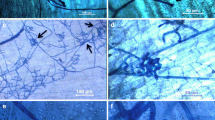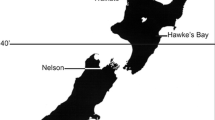Summary
Aspects of Verticillium wilt infection of potato were investigated by determining inoculum survival in vascular discolored potato tubers as evidenced by seed borne disease transmission in the field, isolation attempts, and histological observations. Methods for field inoculation of potato plants were evaluated.
Of the different methods used for inoculation, root inoculation and seed surface contamination were the most effective. The leaf inoculation method induced relatively high infection. The other methods used, hypodermic syringe, tooth pick inoculation, root dip, and cut tuber, were intermediate or ineffective in establishing infection.
No significant differences between stands, vigor, general appearance, yield, vascular discoloration of tubers, or the presence of viable fungus in the tuber were obtained from healthy as compared to vascular discolored seed lots.
Viable fungus in stored vascular-discolored tubers, as demonstrated by isolation from discolored tissue, progressively diminished during 4 and 7 months after harvest.
Variability in fungus survival between seed lots necessitates reservation in making generalizations. In the light of the present evidence it does not seem probable that internal seed borne inoculum is an important factor in transmitting Verticillium wilt in potato.
Discolored portions of vascular tissue of tubers were examined histologically. Granular material and fungus hyphae within the xylem vessels of tubers are shown.
Resumen
Se investigó varios aspectos del marchitamiento de la papa causado por Verticillium (Verticillium wilt) determinando la sobreviencia del inóculo en el sistema vascular descolorado de tubérculos, por medio de transmisión de la enfermedad por semilla en el campo, aislamientos, y observaciones histológicas. Se evaluaron métodor de inoculación de plantas de papa en el campo.
De los métodos usados, la inoculación de raices y la contaminación de la superficie de los tubérculo semilla fueron los más efectivos. El método de inoculación de hojas produjo relativamente alta infeción. Los otros métodos usados, jeringa hipodérmica inoculación con mondadientes, sumersión de raices, y corte de tubérculo, fueron intermedios o infectivos en la produccion de infección.
En comparaciones entre lotes de semilla sana y semilla con descoloracion vascular no se obtuvieron diferencias significativas en el grado de establecimiento de plantas (stand), vigor, apariencia general, rendimiento, o la presencia del hongo viable en tuberculos.
El hongo viable en tuberculos, con descoloración vascular, almacenados (demonstrado por aislamientos de tejidos descolorados), disminuyó progresivamente durante 4 y 7 meses después de la cosecha.
La variación en la sobrevivencia del hongo entre lotes de semilla necesita cierta réserva para hacer generalizaciones. Con la evidencia que disponemos, no es probable que el inóculo interno de la semilla sea un factor importante en la transmisión del marchitamiento causado por Verticillium en la papa.
Se examinaron histologicamente porciones descoloradas de tejidos vasculares. Se muestran material granular e hifa del hongo dentro de las vasos del xilema.
Similar content being viewed by others
Literature Cited
Ayers, G. W. 1952. Studies on Verticillium wilt of potatoes. Amer. Potato J. 29: 201–205.
Ayers, G. W. and R. R. Hurst. 1939. Verticillium wilt of potatoes in Prince Edward Island. Seien. Agr. 19: 722–735.
Brinkerhoff, L. A. 1949. Hypodermic injection as a method of inoculating cotton plants withVerticillium albo-atrum. Phytopathology 39: 495. (Abstr.)
Dale, Elizabeth. 1912. On the cause of “Blindness” in potato tubers. Ann. Bot. 26: 129–131.
Edson, H. A. 1920. Vascular discoloration of Irish potato tubers. J. Agr. Res. 20: 277–294.
Erwin, D. C., W. Moje and I. Malca. 1965. An assay of the severity of Verticillium wilt on cotton plants inoculated by stem puncture. Phytopathology 55: 663–665.
Friedman, B. A. and D. Folsom. 1953. Storage behavior of Kennebec potatoes infected byVerticillium albo atrum. Phytopathology 43: 108. (Abstr.)
Fronek, F. R. 1965. Verticillium wilt resistance in potato. Ph.D. Thesis. Michigan State University.
Hooker, W. J. 1967. A microtome for rapid preparation of fresh sections of plant tissue. Phytopathology 57: 1126–1129.
Isaac, I. 1957. Wilt of lucerne caused by species of Verticillium. Ann. Appl. Biol. 45: 550–558.
Keyworth, W. G. 1962. Verticillium wilt of potatoes in Connecticut, 1951. Plant Dis. Reptr. 36: 16–17.
Keyworth, W. G. and M. Bennett. 1951. Verticillium wilt of the strawberry. J. Hort. Sci. 26: 304–316.
McKay, M. B. 1926. Potato wilt and its control. Bull., Ore. Agr. Exp. Sta. 221: 1–23.
Muncie, J. H. 1954. Resistance of potatoes toVerticillium albo-atrum. Amer. Potato J. 31: 371 (Abstr.)
Patil, S. S., R. L. Powelson and R. A. Young. 1964. Relation of chlorogenic acid and free phenols in potato roots to infection byVerticillium albo-atrum. Phytopathology 54: 531–535.
Pethybridge, G. H. 1916. The Verticillium disease of the potato. Sci. Proc. Royal Dublin Soc. 15: 63–92.
Pitt, D., J. L. Hardie, T. D. Hall and D. C. Graham. 1964. The role ofVerticillium nubilum Pethybr. in causing the coiled-sprout disorder of potatoes. European Potato J. 7: 193.
Provvidenti, Rosario and W. T. Schroeder. 1959. Foliage infection of tomato and eggplant by Verticillium. Plant Dis. Reptr. 43: 821–826.
Reinke, J. and G. Berthold. 1879. Die Zersetzung der Kartoffel durch Pilze. Untersuchungen Bot. Lab. Univ. Göttingen. 1–100. Paul Parey, Berlin.
Robinson, D. B. and G. W. Ayers. 1961. Verticillium wilt of potato in relation to vascular infection of the tuber. Can. J. Plant Sci. 41: 703–708.
Robinson, D. B., R. H. Larson and J. C. Walker. 1957. Verticillium wilt of potato in relation to symptoms, epidemiology and variability of the pathogen. Research Bull. 202, Agr. Exp. Sta., Univ. of Wisconsin.
Rudolph, B. A. 1931.Verticillium hadromycosis. Hilgardia 5: 197–353.
Thanassoulopoulos, C. C. and W. J. Hooker. Aspects of leaf and sprout infection of potato byVerticillium albo-atrmn. Phytopathology.
Author information
Authors and Affiliations
Additional information
Published with the approval of the director of the Michigan Agricultural Experiment Station as Journal Article Number 4155. Research supported in part by grants from the Michigan Potato Industry Council and the Michigan Department of Economic Expansion. Accepted for publication October 3, 1967.
Rights and permissions
About this article
Cite this article
Thanassoulopoulos, C.C., Hooker, W.J. Factors influencing infection of field grown potato by Verticillium albo-atrum. American Potato Journal 45, 203–216 (1968). https://doi.org/10.1007/BF02849394
Issue Date:
DOI: https://doi.org/10.1007/BF02849394




